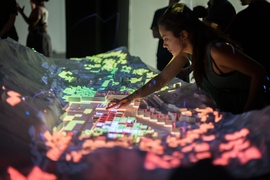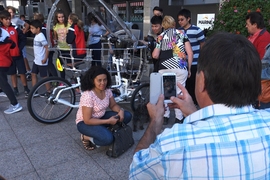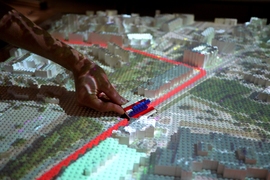When you think of innovation hubs around the world, Andorra, a tiny country tucked between Spain and France, may not come to mind.
But, for several years, the 180-square-mile nation of 77,000 people has served as a “living lab” for researchers from MIT Media Lab’s City Science Initiative to prototype, deploy, and test urban innovation.
The researchers have, for example, developed CityScope Andorra, a 3-D augmented-reality platform that visualizes complex urban data on a small-scale model of the country in real-time. The platform simulates the impact of multiple urban interventions — from urban planning proposals to shared autonomous vehicles — and facilitates civic engagement and decision making.
The researchers have also tested the Persuasive Electric Vehicle (PEV), an ultra-lightweight, three-wheel, shared-use autonomous vehicle designed to operate in bicycle lanes. If deployed at scale, the PEV could help address the severe traffic and parking problems in Andorra, a car-dependent country without an airport or train service.
“Urban innovation that is focused on human interaction must be tested in a real-world context,” says Kent Larson, director of the City Science Initiative, who spearheads the projects. “Working in Andorra is a fantastic opportunity. In such a tiny country, we can work directly with the ministers, policy decisions can be made rapidly and efficiently, and we have access to mobile and energy data for the entire country to help us understand the complex behaviors of residents and tourists.”
Urban modeling and simulation
In 2014, Andorran government officials met with Larson’s City Science Initiative to discuss collaboration opportunities. Andorra had aspirations — and still does — of becoming the world’s first “smart country” by making use of big data to help develop and deploy innovation.
This sparked a partnership in which Andorra would fund the City Science Initiative to develop projects related to data collection and analysis, urban mobility, urban planning for a new innovation district, and sensors deployed in schools for learning.
“In order to solve the great societal challenges of our era — from climate change to jobs to health care to food and water — we have to make cities more responsive to changing economic conditions, human needs, and opportunities related to rapidly evolving technology” Larson says.
A number of notable projects have stemmed from the partnership. One is CityScope Andorra, currently being used in the redevelopment of a district in Andorra la Vella. Urban planners and the community can interactively test scenarios on the model, such as how many parks to include, whether to make buildings taller, the optimal mix of residential and commercial real estate, and whether to allow private vehicles or only car-share services. By weighing the density, proximity, and diversity of the district, Larson adds, Andorra could also determine the city’s “innovation potential,” which is “the probability of creative collisions that can be estimated from the density and mix of people with diverse experiences who have opportunities to exchange ideas.”
Users can add and move modules representing various types of housing or office space, tune the heights of each element, and toggle alternative mobility systems. The impacts of these changes on traffic, walkable access to amenities, and other metrics are then updated in real time.
For Andorra, whose geographical size is only about twice that of Boston, researchers modeled the entire country to analyze, among other things, different behaviors of tourists, an economic driver for the country.
By visualizing how thousands of tourists come and go to major events throughout the year, for instance, CityScope helped the Andorran government improve the experience and analyze the impact of the events, says Josep Maria Missé, Andorra’s secretary of state for economic diversification and innovation.
“CityScope has helped us see how many days people come to, how many people came to see the events, which parts of the country had the most people, and how they move around,” he says. “This will help the planning of future events.”
The researchers also developed and deployed an app to enable children, teachers, government officials, and the public in Andorra’s major cities to capture photos of different areas and document places they like or dislike. “In that way, we can generate these unusual data sets about human perception of an environment and visualize that on CityScope. We are interested in how children and adults may perceive the city differently,” Larson says.
Another project, called TerMITes (which stands for the third-generation of MIT Environmental Sensors), deploys small sensors to schools in Andorra’s capital so students can learn how to measure energy consumption in their buildings and invent strategies to reduce it, while collecting building-efficiency data for CityScope.
“It’s a way to instill innovation in students … and help students learn about energy efficiency,” Missé says, “[while] using it as a tool for planning the future of Andorra.”
Rethinking mobility
For innovation at the street level, the researchers developed the PEV, an autonomous, on-demand vehicle that looks somewhat similar to the cargo bikes found in Amsterdam. In operation, the PEV would “combine the features of a bike-sharing system, such as Boston’s Hubway with the on-demand pick-up and drop-off of an Uber or Lyft service,” Larson says.
The vehicle was designed as an alternative to popular driverless cars and taxis. Driving in Boston, Larson says he averages about 12 miles per hour, which is slower than average bike speeds. “It makes no sense to put one person in a 4,000-pound car that goes 120 miles per hour, to travel a short distance and low speeds,” he says.
Users are meant to call the PEV via an app. The vehicle then navigates a city’s bike lanes to meet the passenger. Computer vision keeps the vehicle within the painted lines and a low-cost Lidar system scans for objects, such as people and other vehicles. Users can pedal themselves or ride in a fully automated mode.
The PEV uses parts that are less expensive than automated cars — meaning the price range would be comparable to that of a high-end bike — and has fewer hurdles to becoming street-ready in a place such as Andorra, which has no restrictions against testing autonomous bike-lane vehicles. By replacing conventional automobiles in cities, such as Andorra’s capital, the PEV has potential to cut emissions by more than 60 percent, Larson says.
So far, Larson’s group has tested the vehicle on the streets of Cambridge and at the Taiwan Air Force Base in Taipei. In Andorra, the group aims to deploy a small fleet of PEVs to study how they impact cities, with an eye toward commercialization. “Next steps are increasingly ambitious testing in the wild,” Larson says. “If successful, we would consider spinning it off as a startup or partnering with one of our corporate sponsors.”
A life of its own
Following MIT’s lead, others are now turning to Andorra as a living lab, including company sponsors of the Media Lab such as Denso, the Japanese automotive supplier.
This is good for Andorra, Missé says. Down the road, the PEV could serve as a platform for further development of autonomous vehicles for various tech companies. Andorra is also crunching retail data with CityScope to help companies better reach and serve their customers. “That’s an important way to include the private sector in these projects,” Missé says.
In September, Larson, MIT researchers, and Andorran government officials hosted an inaugural meeting of the City Science Summit 2017. Presenting their work were researchers representing the international network of City Science collaborators: Tongji University (Shanghai), National Taipei University of Technology (Taipei), Aalto University (Helsinki), and HafenCity University (Hamburg).
The event also saw the opening of an innovation facility in the capital. Located on the ground floor of a public building, the facility contains co-working spaces used for meetings, technological collaborations, and workshops and lectures. An aim is to bring together government officials, urban planners, architects, and the public to work together and use MIT-built technologies to improve the country.
“This is a highly visible community-engagement space, which will be a platform where anything that is related to innovation and the future of Andorra can be presented and discussed,” Larson says.
In a couple of years, Larson says, his group will conclude its work in Andorra. But he hopes that Andorran researchers and companies will carry the torch: “I will consider our project a success if, at the end of our involvement, all these projects we have seeded have a life of their own.”











